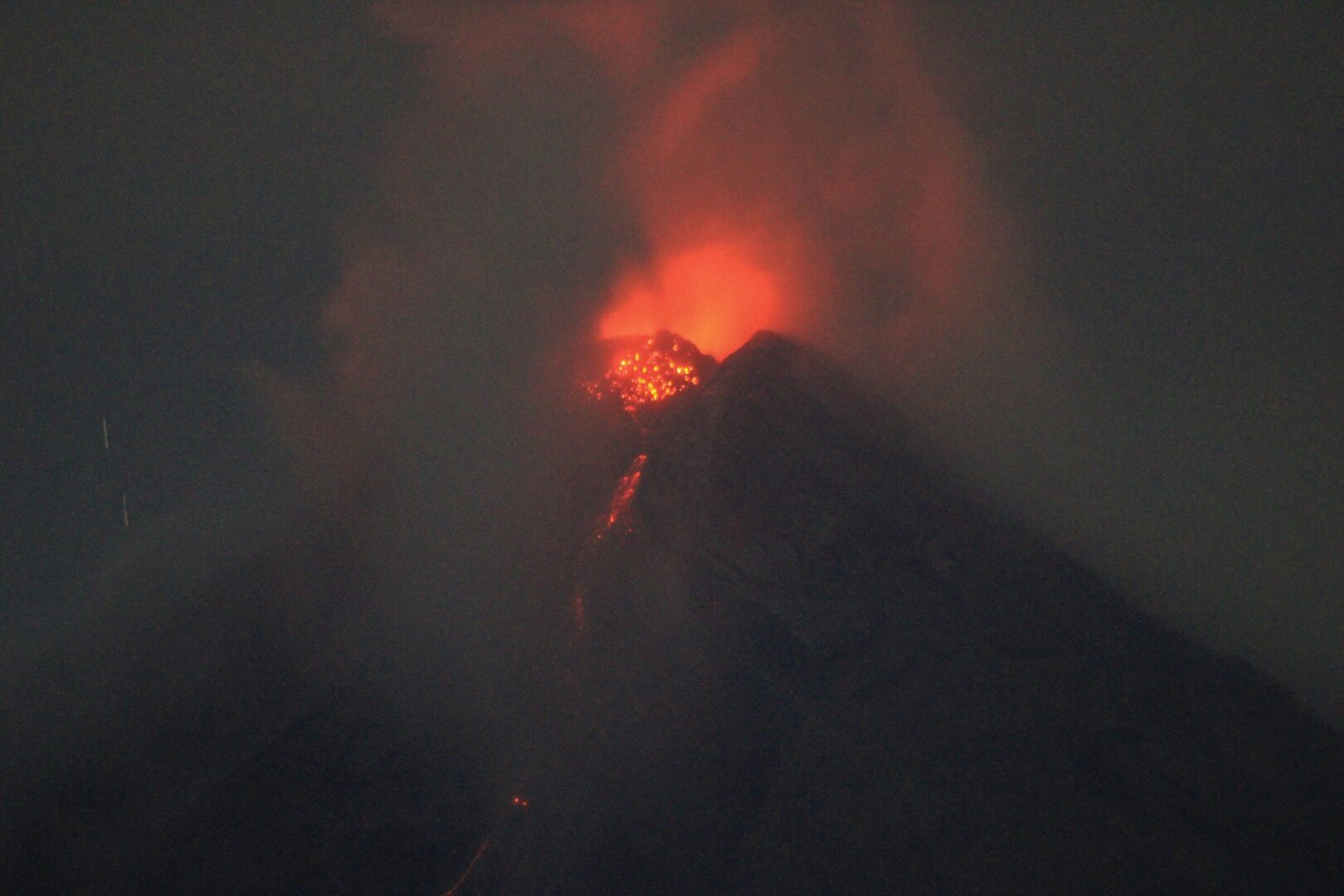Mt. Mayon exhibited intense restiveness on the fifth day after it started to spew volcanic plumes in Legazpi City, Albay on 6 June.
The Philippine Institute of Volcanology and Seismology on Sunday said they recorded one volcanic earthquake and 177 rockfalls on Mayon Volcano.
Based on its 8 a.m. report, Phivolcs said Mayon continues to have “intensified unrest or magmatic unrest” within the last 24 hours after it recorded volcanic earthquakes and rockfalls.
Mayon also sent out amounts of plumes that moved easterly, releasing 1,205 tonnes of sulfur dioxide as of Saturday.
The volcano in Albay still had a fair crater glow that could be seen with the human eye, even though its structure had grown.
In a radio interview on Sunday, Mayon Volcano Observatory’s resident volcanologist Dr. Paul Alanis said Mayon’s current behavior might continue for a few more days based on the volcano’s previous behaviors.
“The lava will flow easily as a new lava dome emerged. This could be the new phase of the Mayon Volcano eruption,” Alanis said.
Phivolcs issued a warning to residents in the area about potential hazards such as rockfalls, landslides, avalanches, ballistic fragments, lava flows, lava fountaining, pyroclastic density currents, moderate-sized explosions, and lahars during periods of heavy and prolonged rainfall.
The agency also reminded the public that they couldn’t enter the six-kilometer radius of the Mayon Volcano’s Permanent Danger Zone. It prohibited everyone from flying any aircraft close to the area.
The local government of Albay placed the province under a state of calamity on Friday due to Mayon Volcano’s increasing activity.
According to the Albay Provincial Information Office, the state of calamity was declared through the provincial government’s Resolution No. 0607-2023 to allow the local government to tap quick response funds to be able to provide support to affected residents in the towns of Camalig, Guinobatan, Tabaco, Santo Domingo, Malilipot, Bacacay, and Daraga, and the cities of Legazpi and Ligao, among others.
Code blue alert
The Department of Health on Sunday placed all government hospitals, including non-Department of Health hospitals, specifically in the province of Albay, under code Blue alert due to Mayon’s increasing activity.
In a virtual media briefing, Health Secretary Ted Herbosa said the DoH-Region 5 raised the code blue alert from the code white alert in Albay.
“(The) DoH Code Blue Alert is a response-level alert for agency resource mobilization. This means that teams have been mobilized to augment existing regular day-to-day resources,” the DoH said.
DoH, he said, has allocated a total of P1.8 million as a contingency fund to affected areas or to treat patients.
“We provided additional money. I ordered our central office, our DRRMO office, to mobilize more money because the regional director asked me for additional funds,” he added.
There are more than 6,300 individuals in 18 active evacuation centers in Albay.
Aside from logistical support, the DoH would also provide psychosocial support to the affected residents.
In coordination with the Department of Social Welfare and Development, DoH will assess children in the evacuation centers in terms of mild, moderate, and severe malnutrition.
The DoH will prioritize children with severe malnutrition, while the DSWD would handle those under mild and moderate.
Herbosa warned the public, particularly tourists who were drawn to watch the volcanic at night, about the health risks of volcanic hazards such as sulfur dioxide and ash fall.
“Its emission consists of sulfur and sulfur dioxide. It sticks with the hemoglobin, it could poison our blood. The dust and ash could stick to our lungs,” he said.
“We should be well-protected. Wear an N95 mask, or better stay away from it. Do not watch it near the affected area,” he added.
Taal, Kanlaon updates
In a separate advisory, Phivolcs said on Sunday that Taal Volcano has been putting out a “moderate,” 900-meter-high plume moving northeast over the past 24 hours.
As of 5 a.m., Phivolcs said the Taal Volcano in Batangas emitted a “pronounced upwelling of hot volcanic fluids in the Main Crater Lake.”
The agency also recorded four volcanic shocks as the Taal Volcano made 6,304 tonnes of sulfur dioxide as of Saturday.
The main crater lake of Taal stayed at a temperature of 74.1 degrees Celsius and an acidity level of 0.48.
No one is allowed to go to Taal Volcano Island, which is also in a Permanent Danger Zone, and no planes are allowed to fly close to the volcano.
Meanwhile, Kanlaon Volcano in Negros has had three volcanic shocks as of Sunday.
Phivolcs said the Kanlaon Volcano plume was hidden, and its edifice was swollen.
As of 5 June, Kanlaon released 1,089 tonnes of sulfur dioxide.
No one is allowed to enter the four-kilometer PDZ around Kanlaon Volcano, and no planes can fly close to it.
Phivolcs said dangers like sudden steam-driven or phreatic eruptions are also possible.
The Taal Volcano and the Kanlaon Volcano are at Alert Level 1, meaning they have “low-level unrest.”
With Edjen Oliquino
